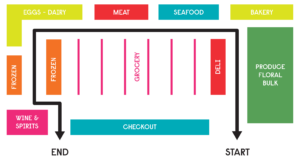TIPS TO EAT HEALTHY ON ANY BUDGET
MEAL PLANNING: Smarter shopping begins before we ever set foot in the store. Depending on how much time you have, it can be helpful to make a menu of the meals you want to make over the next several days. Then, think of ways to reuse ingredients. This will save you the stress of having to figure out what to make when you get home from work each night. It will also help you simplify your shopping list because you can buy a smaller selection of ingredients and reuse them in different ways.
MAKE A LIST: Once you know what meals you’re going to make, create a shopping list. This step is especially important because it will keep you from being tempted by all the food marketing and sales in the store. If it’s not on your list, don’t buy it. This will keep your purchases on track, making sure you have the ingredients you need, and that everything you buy goes to use and not waste. You can also organize your list by item type (for example: produce, canned goods, etc) to make it speedier to find them once you’re in the store.
SHOP THE PERIMETER FIRST: Now you’re ready to go to the store. It’s best to begin in the outer aisles where all of the fresh, whole foods are.

DO NOT SHOP HUNGRY! You may be tempted to buy food not on your list.
BUY PRODUCE THAT IS GROWN LOCALLY AND IS IN SEASON: When shopping for fresh produce, you’ll save money by shopping for only what’s in season. For example, in December, strawberries have to be flown in from distant, warmer climates, making them cost more.
BUY FROZEN WHEN IT’S NOT IN SEASON: If you really want strawberries, look in the frozen food aisle. Frozen fruit and vegetables are picked at the height of ripeness and frozen to preserve them, so they have a high level of nutrients. Just be sure that there are no additional ingredients like sugar, salt, or preservatives.
WHEN IT IS IN SEASON (OR ON SALE) BUY MORE THAN YOU NEED, AND FREEZE THE REST: On the other hand, if it’s summer, and there are fresh strawberries on sale, consider buying extra and freezing them yourself. Speaking of sales, there are often weekly specials on produce that is getting too ripe and needs to be sold. Keep an eye out for deals, and revise your menus accordingly.
CHECK THE UNIT PRICE: Another way to save money is to look at the unit price. The unit price tells you how much the item is by weight or measure. If you just look at the item price, you might choose a product that looks cheaper at first glance. But the unit price is actually the way to tell which item really is cheaper.
CHOOSE WISELY: Finally, avoid convenience foods sold in smaller packages. Manufacturers charge more for the additional packaging. Instead, buy the item with the best unit price, or when possible buy in bulk.
PREP AHEAD: When you get home, wash your lettuce, wrap it in a damp towel, and store it in a zip lock bag. Cut veggies and fruit and store in small containers. This way everything is available—fast and easy—when you’re hungry and need it most. It’s like a healthy version of “fast food.”
RESOURCES TO EAT HEALTHY ON ANY BUDGET
WE ALL NEED SUPPORT! There are many reasons why working individuals and families struggle to find and afford enough food. Programs like WIC, SNAP, and other local programs were created because hunger is an issue facing too many Americans today. If you are currently utilizing the program or in need of these programs, you are not alone. These programs can help make you and your family healthier and less hungry. We can all use any help we can get.
SNAP: SNAP stands for the Supplemental Nutrition Assistance Program. It was created in order to ensure that all Americans have enough to eat. With SNAP, a monthly stipend is provided based on income level and number of family members in the home. For many individuals and families, it can be a source of support each month, allowing you to put a little more food on the table.
WIC: Another resource that can be helpful is WIC. Rather than individuals or families in general, WIC was created to support Women, Infants and Children (up to age 5) by providing additional nutritional and educational benefits. WIC Is also a very useful resource to get education about women’s health, breastfeeding, and much more. WIC programs vary state-to-state and funding is often limited. Search for the WIC number for your city or state to apply.
LOCAL BENEFITS: Depending on where you live, there are numerous local programs you also may be eligible for. To search online for all national programs you may be eligible for, go to www.benefits.gov.
MARKET MATCH: Market Match is California’s healthy food incentive program, which matches customers’ federal nutrition assistance benefits, like CalFresh and WIC, at farmers’ markets and other farm-direct sites.